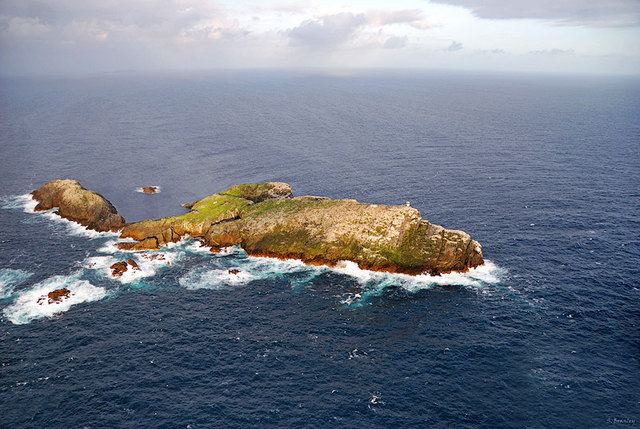Gaelic name Sula Sgeir Area 15 ha NGA number 3572 | Norse name Súlasker Population 0 Lieutenancy area Comhairle nan Eilean Siar | |
 | ||
Island groups British Isles, Outer Hebrides | ||
Trip to sula sgeir guga hunters sept 2009
Sula Sgeir is a small, uninhabited Scottish island in the North Atlantic, 18 kilometres (11 miles) west of North Rona. One of the most remote islands of the British Isles, it lies more than forty miles (64 kilometres) north of Lewis and is best known for its population of gannets.
Contents
- Trip to sula sgeir guga hunters sept 2009
- Map of Sula Sgeir
- EtymologyEdit
- LegendEdit
- HistoryEdit
- FaunaEdit
- Media and the artsEdit
- References
Map of Sula Sgeir
Although seemingly very inhospitable to humans, there is a ruined stone bothy called Taigh Beannaichte (Blessed House) on the east headland Sgeir an Teampaill. The hard gneiss rock of which the island is made splits into long pieces, which are excellent for building bothies and cairns, but the hard rough boulders and sharp rocks make for difficult walking.
The sea has burrowed right through the southern part of the island in a series of interconnected and spectacular caves which can be explored in calm weather by inflatable. The small lighthouse on the south end at Sròn na Lice is regularly damaged by the huge seas which break right over the rock during Atlantic storms.
Despite this there is a surprising amount of vegetation, and the thrift is especially colourful in June, which is probably the best month to visit.
EtymologyEdit
The modern name is from the Old Norse súla, "gannet" and sker, "skerry". In the 16th century Dean Munro referred to the island as "Suilskeray". Macculloch's 1819 Description refers to "Sulisker", an Anglicised spelling that is still occasionally used. A skerry in Utsira, Norway has a name with the same origin, Suleskjer; there is also a Sule Skerry in Orkney.
LegendEdit
St Ronan's sister, Brenhilda, is supposed to have stayed here for some time, leaving him on Rona, only to be found dead in a bothy with a shag’s nest in her ribcage.
HistoryEdit
Sula Sgeir has a special place in the seafaring history of the men of the Ness district on Lewis. Dean Munro visited the Hebrides in 1549 and his is one of the earliest accounts written about the Western Isles. His description of Sula Sgeir mentions that the men of Ness sailed in their small craft to "fetche hame thair boatful of dry wild fowls with wild fowl fedderi". How long before 1549 the Nessmen sailed to Sula Sgeir each year to collect the young gannets for food and feathers is not known, but it may be assumed that it was a tradition for centuries. That tradition is still carried on today. A report written in 1797 says:
"There is in Ness a most venturous set of people who for a few years back, at the hazard of their lives, went there in an open six-oared boat without even the aid of a compass."The flesh of the young gannet or guga is regarded as a delicacy in Ness today though, for others, it is an acquired taste. It was a popular meat in earlier times in Scotland. In the sixteenth century it was served at the tables of Scots kings and was a favourite with the wealthy as a ’whet’ or appetizer before main meals. In the autumn of each year, a group of 10 Nessmen set sail for Sula Sgeir to kill a maximum of 2,000 young birds. They set up residence for about two weeks in stone bothys. Working in pairs, the men take the fledglings from their nests with poles, catching them around the neck with a rope noose, then killing the birds with a blow to the head. They bring home their catch to meet an eager crowd of customers. The demand is often so great that the birds have to be rationed out to ensure that each person does not go without a taste of guga. In 2009, a single guga fetched £16.
The Sula Sgeir hunt, which would otherwise be illegal under the Wildlife and Countryside Act 1981, receives an annual licence from the government, which allows it to continue. Scottish Natural Heritage, which is now responsible for granting the licence, states that the hunt is sustainable, although it has been criticised by animal welfare groups. The Scottish SPCA describes it as "barbaric and inhumane" and believes it causes unnecessary suffering to the birds, with many taking several blows to be killed.
FaunaEdit
There are some 5,000 breeding pairs of gannets on Sula Sgeir, which they share with other bird species such as black-legged kittiwakes, guillemots, puffins, fulmars and in the summers of 2005 to 2007 a Black-browed Albatross was resident in the gannet colony.
Together with North Rona, Sula Sgeir was declared a national nature reserve in 1956 because of its importance for birdlife and grey seal breeding. The reserve is now managed by Scottish Natural Heritage and is the most remote and least-visited national nature reserve in Britain.
